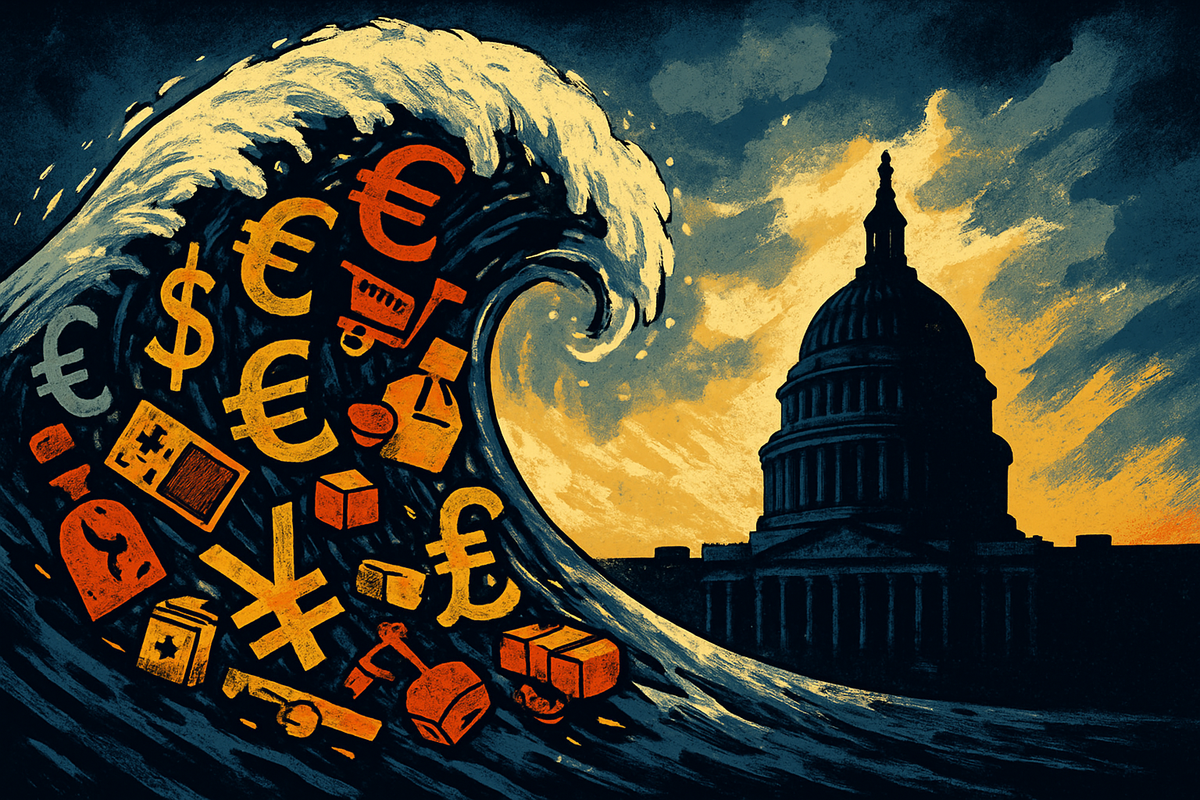
The specter of a second Donald Trump presidency, coupled with a Republican-controlled Congress, is poised to unleash a seismic shift in U.S. trade policy, fundamentally reshaping the global economic landscape. At the heart of this anticipated transformation lies a fervent commitment to economic nationalism, with tariffs emerging as the primary weapon in a renewed "America First" arsenal. This aggressive stance is expected to send ripple effects through supply chains, elevate consumer prices, and significantly complicate the nation's inflation outlook, presenting a formidable challenge to both businesses and households.
The immediate implications are stark: a likely surge in import costs as tariffs are imposed across a broad spectrum of goods. This direct tax on imports, paid by U.S. businesses, will inevitably translate into higher retail prices for consumers, dampening purchasing power and potentially slowing economic growth. The prospect of widespread tariffs has already ignited debates among economists and policymakers, with many warning of an inflationary spiral and the potential for a period of stagflation, where economic growth stagnates while prices continue to climb.
The Return of "America First": A Tariff-Driven Trade Revolution
Donald Trump's potential return to the Oval Office signals a decisive pivot back to an "America First" trade doctrine, characterized by a deep-seated economic nationalism aimed at prioritizing domestic manufacturing, reducing trade deficits, and extracting more favorable terms from international trading partners. This approach views global trade as a zero-sum game, where the U.S. must aggressively protect its interests to regain perceived technological, economic, and military advantages.
The cornerstone of this strategy is a sweeping reintroduction and expansion of tariffs. Trump has outlined a multi-tiered tariff plan, including a baseline 10% universal tariff on nearly all imported goods, which, according to some sources, took effect on April 5, 2025. Beyond this blanket measure, significantly higher duties are proposed for specific nations, such as 20-30% on the European Union, 34-60% on China, and a staggering 25-100% on Mexico. Strategic industries are also targeted, with a 25-100% tariff on all foreign-made automobiles and parts, explicitly designed to revitalize American car manufacturing. Furthermore, the administration has threatened 100% tariffs on BRICS nations should they pursue an alternative currency to the U.S. dollar, underscoring the geopolitical dimensions of this trade agenda. These tariffs are often justified under the International Emergency Economic Powers Act (IEEPA), framing large and persistent trade deficits as a national emergency requiring decisive action.
The timeline leading up to this moment has been characterized by a consistent rhetoric from Trump regarding trade imbalances and the need for protectionist measures, echoing his first term's policies. Key players include the President himself, the U.S. Trade Representative, and various industry lobbying groups. Initial market reactions have been cautious, with some sectors expressing concern over potential supply chain disruptions and increased costs, while others, particularly domestic manufacturers, anticipate a competitive advantage. Republican control of Congress is largely expected to facilitate this agenda, as a growing segment of the party has embraced protectionist policies, and the President's executive authority over trade provides significant leeway.
Navigating the New Landscape: Winners and Losers in a Tariff-Laden Economy
The re-emergence of a tariff-heavy trade policy under a potential Trump administration will undoubtedly create a distinct set of winners and losers across various industries and public companies. The impact will be felt differently depending on a company's reliance on imports, its manufacturing base, and its ability to adapt to shifting trade dynamics.
Domestic manufacturers, particularly those in sectors targeted for protection, stand to gain significantly. Companies like Ford Motor Company (NYSE: F) and General Motors Company (NYSE: GM), with substantial U.S. manufacturing operations, could see increased demand for their domestically produced vehicles and parts if tariffs make imported automobiles prohibitively expensive. Similarly, American steel producers such as United States Steel Corporation (NYSE: X) and Nucor Corporation (NYSE: NUE) could benefit from reduced competition from foreign imports, potentially leading to higher prices and increased market share. Companies that have already invested in reshoring or nearshoring their production could also find themselves in a more advantageous position.
Conversely, companies heavily reliant on imported goods and components will likely face substantial headwinds. Retailers, for instance, such as Walmart Inc. (NYSE: WMT) and Target Corporation (NYSE: TGT), which source a vast array of products from overseas, will see their cost of goods sold increase, forcing them to either absorb the costs, reduce profit margins, or pass the increases on to consumers. Technology companies like Apple Inc. (NASDAQ: AAPL), which assemble many of their products in countries like China, could face significant challenges due to higher tariffs on components and finished goods, potentially impacting their global supply chains and pricing strategies. The automotive industry, despite potential domestic gains, could also see losers among companies that import a large percentage of their vehicles or parts, or those that rely on complex international supply chains. Consumers, ultimately, will bear the brunt of these tariffs through higher prices for a wide range of goods, from electronics and apparel to furniture and food.
Industry Impact and Broader Implications: A Shift in Global Trade Dynamics
The anticipated return of a tariff-centric trade policy under a potential Trump administration represents more than just a policy shift; it signifies a fundamental reorientation of global trade dynamics with far-reaching implications for industries, international relations, and the regulatory landscape. This event fits squarely into a broader trend of increasing economic nationalism and de-globalization that has been gaining traction worldwide, challenging decades of free-trade orthodoxy.
The ripple effects on competitors and partners will be profound. Trading partners, particularly those targeted with higher tariffs like China, Mexico, and the European Union, are likely to retaliate with their own tariffs on U.S. exports, creating a tit-for-tat trade war that could harm American agricultural producers and manufacturers reliant on foreign markets. This could lead to a fragmentation of global supply chains, as companies seek to diversify their sourcing away from tariff-affected regions or move production closer to end markets. Industries such as agriculture, which relies heavily on exports, could face significant challenges as foreign markets become less accessible or more expensive. The automotive industry, already grappling with the transition to electric vehicles, will face additional complexities as tariffs on parts and finished vehicles reshape production strategies and consumer choices.
Regulatory and policy implications are also significant. The extensive use of the International Emergency Economic Powers Act (IEEPA) to implement tariffs could set a precedent for future administrations to bypass traditional legislative processes in trade policy. This approach could lead to increased uncertainty and volatility in trade relations, as policy decisions become more susceptible to executive discretion. Historically, periods of high tariffs, such as the Smoot-Hawley Tariff Act of 1930, have been associated with reduced global trade, economic downturns, and heightened international tensions. While the modern global economy is far more integrated, these historical precedents serve as a cautionary tale regarding the potential for protectionist policies to trigger broader economic instability. The move towards "friend-shoring" or "ally-shoring" could accelerate, as companies and governments prioritize supply chain resilience and geopolitical alignment over pure cost efficiency.
What Comes Next: Navigating an Uncertain Economic Horizon
The path forward under a renewed tariff regime presents a complex tapestry of short-term adjustments and long-term strategic pivots for businesses, investors, and consumers alike. In the immediate future, companies will be scrambling to assess the direct impact of tariffs on their cost structures and supply chains. This will likely involve a rapid re-evaluation of sourcing strategies, potential price adjustments, and a heightened focus on inventory management to mitigate the initial shock. Consumers, in the short term, should brace for higher prices across a wide array of goods, which could lead to a contraction in discretionary spending.
Looking further ahead, the long-term possibilities include a significant restructuring of global manufacturing and trade flows. Companies may accelerate investments in domestic production or explore new sourcing locations in countries not subject to U.S. tariffs. This could create market opportunities for logistics providers, domestic manufacturers, and companies specializing in automation and advanced manufacturing technologies. However, it also poses challenges for businesses deeply embedded in existing global supply chains, requiring substantial capital expenditure and strategic adaptation. The potential for retaliatory tariffs from trading partners remains a significant risk, which could further complicate export markets for U.S. companies.
Potential scenarios range from a relatively contained inflationary shock, where companies absorb some costs and consumers adjust spending, to a more severe stagflationary environment, where persistent high inflation combines with economic stagnation. Investors will need to closely monitor inflation data, consumer spending trends, and corporate earnings reports for signs of how these policies are impacting the real economy. Strategic pivots may include a greater emphasis on domestic market penetration, diversification of international operations, and a focus on products and services less susceptible to trade barriers. The emergence of new trade blocs or agreements, designed to circumvent U.S. tariffs, is also a distinct possibility, further fragmenting the global trading system.
Conclusion: A Defining Moment for U.S. Trade and the Global Economy
The potential return of Donald Trump to the U.S. presidency, coupled with a Republican-controlled Congress, marks a defining moment for U.S. trade policy and the broader global economy. The anticipated embrace of aggressive economic nationalism, primarily through the widespread imposition of tariffs, represents a significant departure from decades of free-trade principles and is poised to usher in a period of profound economic adjustment and uncertainty.
The key takeaways from this impending shift are clear: higher prices for consumers, increased costs for businesses reliant on imports, and a likely re-evaluation of global supply chains. While domestic manufacturers in protected sectors may see a boost, the overall inflationary pressure and potential for reduced consumer spending could dampen economic growth. The Federal Reserve faces a "complicated challenge" in managing inflation in an environment where tariffs are directly contributing to price increases, potentially pushing the inflation rate closer to 4% and complicating interest rate decisions.
Moving forward, investors should closely watch several critical indicators. These include the trajectory of inflation, particularly as tariff effects filter through supply chains; consumer spending patterns, which will reflect the impact of higher prices on household budgets; and the responses of international trading partners, as retaliatory measures could escalate trade tensions. Corporate earnings reports will provide crucial insights into how individual companies are adapting to the new trade landscape, highlighting those successfully navigating the challenges and those struggling to adjust. The lasting impact of these policies could be a more fragmented global trading system, a renewed focus on domestic production, and a sustained period of elevated prices, fundamentally reshaping the economic environment for years to come. The coming months will be critical in determining the precise contours of this new era of economic nationalism.






